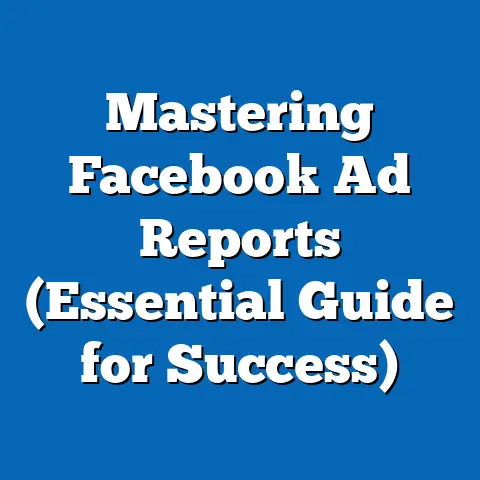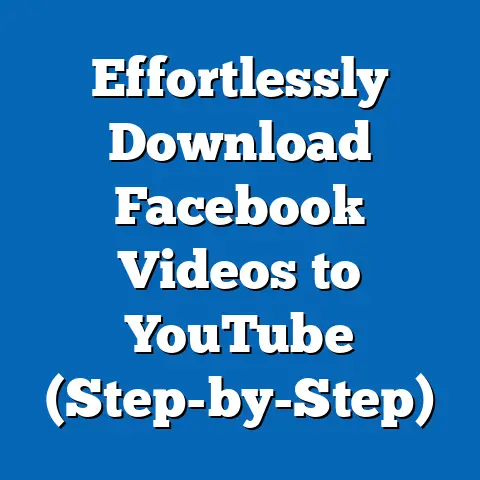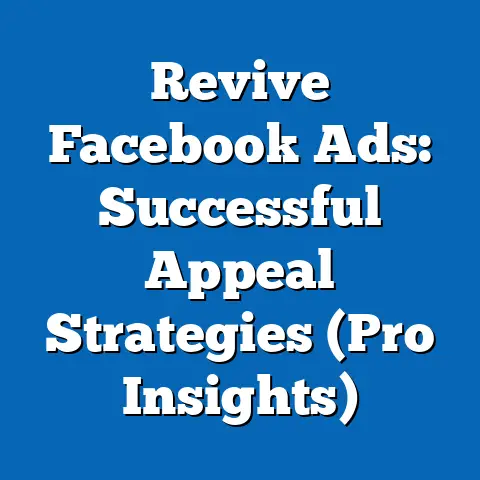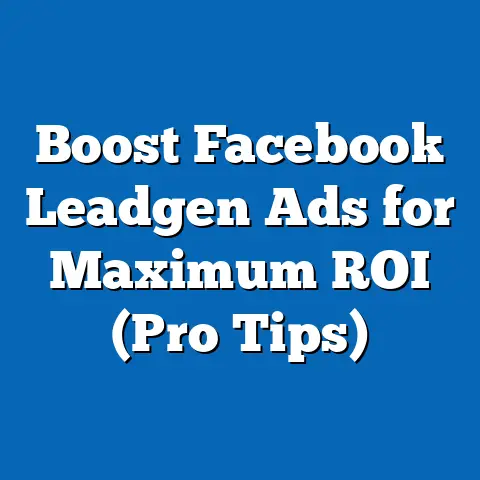Remove Facebook Video Ads (Expert Strategies Unveiled)
Did you know that over 8 billion videos are watched on Facebook every single day? That’s a staggering number, and it highlights the massive potential of video advertising. However, amidst all this activity, many marketers find themselves struggling to achieve their desired results with video ads. I’ve been there myself, launching campaigns with high hopes only to be met with disappointing metrics. That’s why understanding how to effectively manage your video ads, including knowing when to pull the plug, is absolutely crucial.
In this article, I’m going to dive deep into the world of Facebook video ads and share expert strategies for identifying, removing, and learning from underperforming campaigns. This isn’t just about cutting losses; it’s about optimizing your ad spend, improving overall campaign performance, and setting yourself up for future success. Let’s get started!
Understanding the Landscape of Facebook Video Ads
Facebook video ads have become a cornerstone of digital marketing. They offer a dynamic and engaging way to connect with audiences, tell brand stories, and drive conversions. But to truly understand their importance, let’s look at some key statistics.
- Engagement: Video ads consistently outperform static image ads in terms of engagement. People are simply more likely to watch, like, comment, and share videos.
- Conversion Rates: When done right, video ads can significantly boost conversion rates. A compelling video can capture attention, build trust, and motivate viewers to take action.
- Mobile Dominance: The vast majority of Facebook users access the platform on their mobile devices. Video ads are perfectly suited for this mobile-first environment, providing a seamless and immersive viewing experience.
Businesses leverage video ads on Facebook for a multitude of reasons:
- Brand Awareness: Videos are excellent for introducing your brand to new audiences and creating a lasting impression.
- Lead Generation: Through compelling content and clear calls-to-action, video ads can effectively generate leads for your business.
- Direct Sales: Video ads can directly promote products or services and drive sales through targeted campaigns.
- Website Traffic: By including website links in your video ads, you can drive traffic to your website and increase brand visibility.
However, not all video ads are created equal. Despite their potential, many video ads fail to perform as expected. I’ve seen firsthand how a poorly executed video ad can drain your budget without yielding any significant results. Some common reasons for failure include:
- Irrelevant Content: If your video doesn’t resonate with your target audience, it’s unlikely to generate any meaningful engagement.
- Poor Production Quality: Blurry visuals, muffled audio, or unprofessional editing can immediately turn viewers off.
- Lack of Clear Messaging: If your video doesn’t clearly communicate your value proposition, viewers may not understand what you’re offering.
- Weak Call-to-Action: Without a compelling call-to-action, viewers may not know what you want them to do after watching your video.
- Incorrect Targeting: Showing your video to the wrong audience is a surefire way to waste your ad spend.
Takeaway: Facebook video ads are powerful tools, but they require careful planning, execution, and monitoring. Understanding the landscape and potential pitfalls is the first step towards creating successful campaigns.
Identifying Underperforming Video Ads
So, how do you know when a video ad is simply not cutting it? The key is to monitor key metrics within Facebook Ads Manager and analyze audience feedback. I’ve learned that a proactive approach to monitoring can save you a lot of money and frustration in the long run.
Here are some key metrics to keep an eye on:
- View Rate: This metric measures the percentage of people who watched your video. A low view rate indicates that your video isn’t capturing attention or that your targeting is off.
- Engagement Rate: This metric measures the number of interactions (likes, comments, shares) your video receives relative to the number of views. A low engagement rate suggests that your video isn’t resonating with your audience.
- Click-Through Rate (CTR): This metric measures the percentage of people who clicked on your video ad. A low CTR indicates that your video isn’t compelling enough to drive traffic to your website or landing page.
- Cost Per Result (CPR): This metric measures the cost of achieving your desired result (e.g., website visit, lead generation, purchase). A high CPR indicates that your campaign is inefficient and needs optimization.
- Return on Ad Spend (ROAS): This metric measures the revenue generated for every dollar spent on advertising. A low ROAS indicates that your campaign isn’t profitable.
Beyond the numbers, it’s crucial to pay attention to audience feedback. Read the comments on your video ads to gauge sentiment and identify any recurring issues. Are people praising your video or complaining about it? Are they asking questions or expressing confusion? This qualitative feedback can provide valuable insights that quantitative metrics alone can’t capture.
Here are some red flags that indicate a video ad may need to be removed:
- High Abandonment Rates: If viewers are dropping off early in your video, it suggests that your content isn’t engaging enough.
- Negative Comments: A barrage of negative comments can damage your brand reputation and deter potential customers.
- Low Engagement and CTR: If your video is generating minimal engagement and clicks, it’s unlikely to achieve your desired results.
- High CPR and Low ROAS: If your campaign is costing you more than it’s generating in revenue, it’s time to reassess your strategy.
- Irrelevant Traffic: If your video is driving traffic to your website, but those visitors aren’t converting, it suggests that your targeting is off or your video isn’t aligned with your website content.
Takeaway: Regularly monitor your video ad metrics and audience feedback. Don’t be afraid to pull the plug on underperforming ads and learn from your mistakes.
Expert Strategies for Removing Facebook Video Ads
Once you’ve identified a video ad that’s not performing, the next step is to remove it from your campaign. This process is straightforward, but it’s important to do it correctly to ensure that your ad spend is optimized.
Here’s a step-by-step guide to removing video ads from Facebook Ads Manager:
- Log in to Facebook Ads Manager: Access your Ads Manager account through your Facebook business page.
- Navigate to the Ad Set or Ad Level: Locate the ad set or individual ad that contains the video you want to remove.
- Pause or Delete the Ad: You have two options: pause the ad to temporarily stop it from running, or delete it permanently. I usually recommend pausing first, giving you the option to reactivate it later if needed.
- Confirm Your Action: Facebook will prompt you to confirm your decision. Review your selection and click “Confirm” to proceed.
Removing underperforming ads promptly is crucial for several reasons:
- Optimizing Ad Spend: By cutting off the flow of money to ineffective ads, you can reallocate your budget to more promising campaigns.
- Improving Overall Campaign Performance: Removing underperforming ads can boost your overall campaign metrics by eliminating the drag of low-performing content.
- Protecting Brand Reputation: Removing ads that are generating negative feedback can prevent further damage to your brand image.
Regularly auditing your ad performance is essential for maintaining a clean and efficient ad account. I typically recommend setting aside time each week to review your campaigns and identify any underperforming ads. This proactive approach can help you stay ahead of the curve and optimize your ad spend for maximum results.
Takeaway: Removing underperforming video ads is a simple but crucial step in optimizing your Facebook advertising campaigns. Don’t hesitate to take action when you identify ads that aren’t meeting your expectations.
Learning from Removed Video Ads
Removing a video ad might feel like a failure, but it’s actually an opportunity to learn and improve your future campaigns. I’ve found that analyzing why an ad didn’t work can be just as valuable as celebrating a successful campaign.
Here are some strategies for extracting valuable insights from removed ads:
- Analyze the Data: Review the metrics for the removed ad to identify any patterns or trends. Did it perform poorly across all demographics, or was it only underperforming with certain audiences?
- Examine the Creative: Take a critical look at the video itself. Was the messaging clear and concise? Were the visuals engaging? Did it effectively communicate your value proposition?
- Consider the Targeting: Evaluate your targeting settings. Were you reaching the right audience? Were your interests and demographics too broad or too narrow?
- Review the Landing Page: If your video ad was driving traffic to a landing page, assess its effectiveness. Was the landing page relevant to the video? Was it easy to navigate? Did it have a clear call-to-action?
- A/B Testing: Use the insights you’ve gained to create new variations of your video ad and run A/B tests. Experiment with different headlines, visuals, calls-to-action, and targeting options to see what resonates best with your audience.
A/B testing is a powerful tool for optimizing your video ads. By testing different elements of your ads, you can identify the most effective combinations and improve your overall campaign performance.
Here are some examples of A/B tests you can run:
- Headline Testing: Test different headlines to see which one generates the most clicks.
- Visual Testing: Experiment with different visuals (e.g., images, videos, animations) to see which ones capture the most attention.
- Call-to-Action Testing: Test different calls-to-action to see which one drives the most conversions.
- Targeting Testing: Experiment with different targeting options to see which audience is most responsive to your video ad.
Iterative learning is the key to long-term success with Facebook video ads. By continuously analyzing your results, experimenting with new approaches, and adjusting your creative elements, you can refine your strategy and improve your overall campaign performance.
Takeaway: Don’t view removed video ads as failures, but rather as learning opportunities. Analyze the data, examine the creative, consider the targeting, and run A/B tests to improve your future campaigns.
Best Practices for Future Video Ads
Now that you’ve learned how to identify, remove, and learn from underperforming video ads, let’s talk about how to create effective video ads that resonate with your target audience.
Here are some expert recommendations for creating compelling video ads:
- Know Your Audience: Before you even start creating your video, take the time to understand your target audience. What are their interests, needs, and pain points? How can your video address those needs and resonate with their values?
- Keep it Short and Sweet: Attention spans are short, especially on social media. Aim for a video length of 15-30 seconds to capture attention and deliver your message effectively.
- Grab Attention Immediately: The first few seconds of your video are crucial for capturing attention. Use a compelling visual, a catchy headline, or a thought-provoking question to hook viewers from the start.
- Tell a Story: Storytelling is a powerful way to connect with your audience on an emotional level. Use your video to tell a compelling story that showcases your brand values and resonates with viewers.
- Showcase Your Value Proposition: Clearly communicate the value of your product or service. What problem does it solve? How will it benefit viewers?
- Use High-Quality Visuals and Audio: Invest in high-quality visuals and audio to create a professional and engaging viewing experience.
- Include a Clear Call-to-Action: Tell viewers exactly what you want them to do after watching your video. Do you want them to visit your website, sign up for your email list, or make a purchase?
- Optimize for Mobile: Most Facebook users access the platform on their mobile devices. Optimize your video for mobile viewing by using vertical or square aspect ratios and adding captions for viewers who watch with the sound off.
- Test and Iterate: Don’t be afraid to experiment with different video formats, messaging, and targeting options. Continuously test and iterate to find what works best for your audience.
The role of storytelling in video ads cannot be overstated. A well-crafted story can captivate viewers from the first few seconds and create a lasting impression. Think about how you can use your video to tell a story that showcases your brand values, resonates with your audience, and motivates them to take action.
Takeaway: Creating effective video ads requires careful planning, execution, and optimization. By following these best practices, you can create compelling videos that resonate with your target audience and drive results.
Conclusion
Effectively managing Facebook video ads is an ongoing process that requires careful monitoring, analysis, and optimization. Knowing when to remove underperforming ads is just as important as knowing how to create successful ones. By following the strategies outlined in this article, you can optimize your ad spend, improve overall campaign performance, and set yourself up for long-term success in the competitive landscape of social media advertising.
Remember, every removed video ad is an opportunity to learn and improve. By analyzing your results, experimenting with new approaches, and adjusting your creative elements, you can refine your strategy and create compelling video ads that resonate with your target audience. So, don’t be afraid to take action, learn from your mistakes, and continuously strive to improve your Facebook video advertising campaigns.






